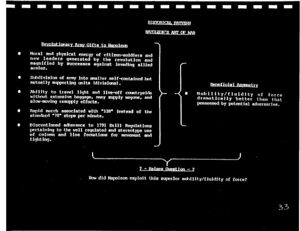Patterns of Conflict
| The works of |
| Works of John Boyd |
|---|
OODA WIKI Edition
Quantico Transcription
We look at Napoleon, we find out, here was what some people call revolutionary army, gifts to Napoleon. Moral and physical energy of the citizen-soldier, and new leader. Remember, the people are now going to get a piece of the action, so they get this moral elan, they really want to go for it. Because they’re going be part of the game now, instead of being held down by the aristocracy and Marie Antoinette, let them eat cake.
Okay, another concept that came up prior to Napoleon: the idea of subdividing the army. What we call today the divisional concept, instead of [unintelligible] which makes it a much more flexible instrument. And of course, if you have that, remember, think of it this way: if you have one rigid body going in, it’s very immobile, you got all these thrusts going there, you really start pulling the other guy apart. You get at his flanks and rear, if you really pull, you get at his flanks and rear. That means you have to be a good commander, but of course Napoleon was that kind of a good commander.
And the idea of living off the countryside, traveling light. In other words, sort of a reaction against 18th century warfare where they had all these supplies, so they live off the countryside, you operate at a much faster pace. Remember that’s what the Mongols did, living off the countryside, going 50-60 miles every day. And sometimes you see this in the rapid march, 120 instead of a standard 70 steps per minute. Sounds like a contractor’s brochure here.
[unintelligible]
[end of Tape 1, Side 2]
[begin Tape 2, Side 1]
Boyd: [unintelligible] use of line and column: initially, even though they were, in effect they weren’t adhered to. Okay, so when you pull all that together, and here’s the asymmetry that Napoleon got over his adversaries. Mobility and fluidity of force much better than his
adversaries. At least where we’re going. And of course we raise the question, how does he exploit this? So let’s look into that. Okay.
